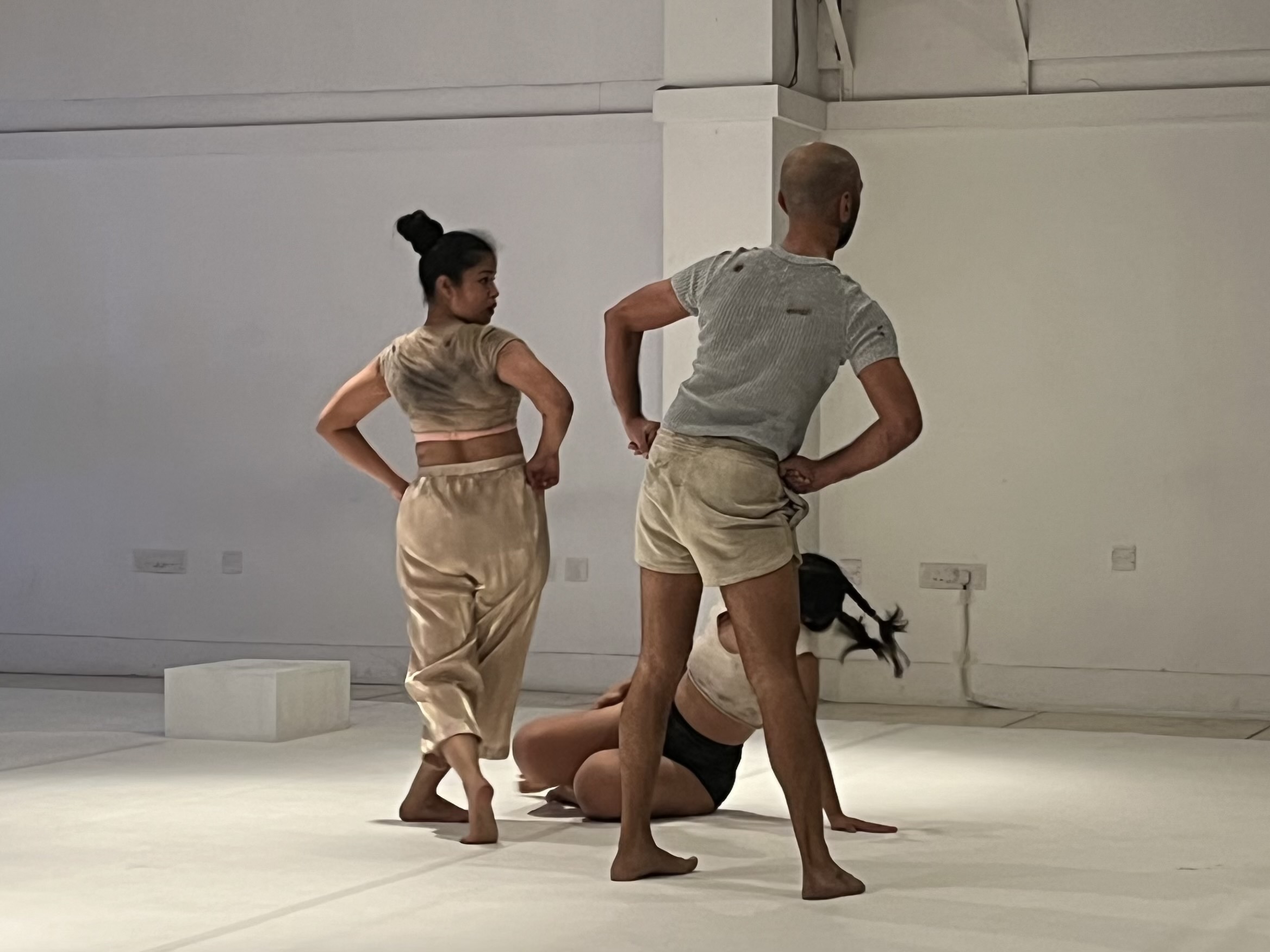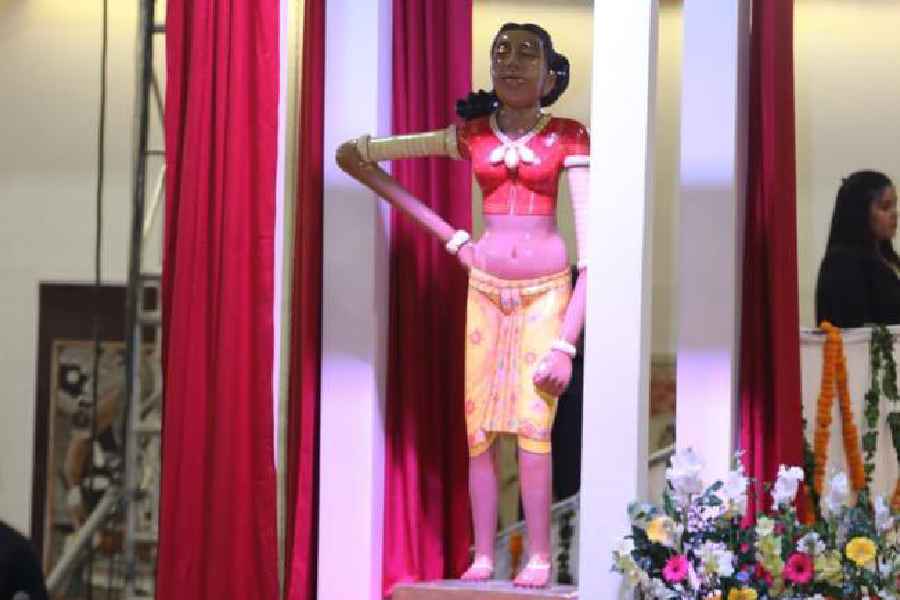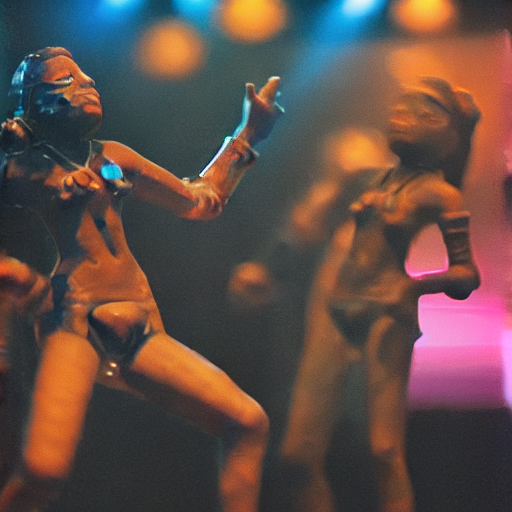Counter-Mythologies in Mandeep Raikhy’s Hallucinations of an Artifact
AUTHOR
Gauri Yadav and Rayan Chakrabarti
Hallucinations of an Artifact [1] is a 50-minute-long performance work by choreographer-dancer Mandeep Raikhy which resuscitates the figure of the ‘Dancing Girl’ of Mohenjo-daro. On stage we see this possibility being enacted and probed by three dancers—Akanksha, Manju, and Meghna—performing around three small pedestals. This work is an important inquiry into popular imagination—what are the qualities associated with the body of a dancer and how have these been formulated through colonial nomenclatures and post-colonial ideas of Classical Indian dance forms? Raikhy is also engaging here with the contentious politics—of gender and culture—converging upon a heritage artefact like the Dancing Girl.
In Hallucinations, there are several bodies to account for—the audience’s memory of the bronze figure from Mohenjo-daro, the three performers, and the indefinite number of figures in the AI projection. The performers replicate the stiffness of a bronze figure to enact what the artefact would look like if it came to life. The posture of the Dancing Girl with the hand on her hip with the left step slightly forward, is the basis for most of the movement in the performance.

But they are constantly breaking out of this pose by inverting their arms, by raising their fists in the air or arranging their bodies in a plank or in the downward dog position, a yogasana. Through interventions like these, the performers create not replicas but afterlives of the figurine by negating its popular imagination as a dancer alone and pushing the limits of what could be typified as ‘dance’. The movements are a jarring collection of everyday postures, popular dance steps, and yoga poses stitched together by frenetic runs along the length of the stage.
Close-up footage of the figures’ body parts is played as the performers in the foreground enact play, conflict, sex, and rest. The performers seem like predators out preying as they scream, push, and run from and towards each other. In one scene, the three performers embody a spirit of playfulness, as they strut about trying to intimidate the others. Two of them corner the third when she suddenly pushes out with her fist on the shoulder and the elbow sticking out like a gun. This section comes to an end as one of the performers runs off and begins rapid hip and arm movements standing next to the wall. Against settled meanings, this artefact offers the power of the erotic. It is this state of the transformation of chaos into eros that Audre Lorde explains in Sister Outsider:
The very word erotic comes from the Greek word eros, the personification of love in all its aspects— born of Chaos, and personifying creative power and harmony. When I speak of the erotic, then, I speak of it as an assertion of the lifeforce of women; of that creative energy empowered, the knowledge and use of which we are now reclaiming in our language, our history, our dancing, our loving, our work, our lives.[2]
The information brochure handed out before the performance at Black Box Okhla, calls it a ‘playful and notoriously unclassifiable artifact’. This ‘play’ becomes a means of empowering an alternate understanding of what the artefact could possibly be about. In the performance, the figure comes to life with a brashness and swagger which is uncharacteristic of its memory as a graceful and petite ‘dancing girl’. When the artefact was excavated in 1926, British archaeologists[3] named it on the basis of colonial perceptions of Indian Classical dance. Raikhy uses movement vocabularies to decolonise the ‘dancing’ figure itself. Would this iteration of the Dancing Girl be classified as a dancer?
The questions of classification bleed into the perceptions of the audience. The performance’s interaction with the public is two-fold. Firstly, the performing body exceeds the demarcated space of the arena. In one instance, the dancer falls into the lap of someone in the audience. Another time, the performer sustains eye contact while making a powerful hissing sound. Secondly, Raikhy’s oeuvre points to his constant engagement with public discourse, whether through short performance pieces like Secular India staged in JNU in February 2023 or Queen Sized, a work which critiques Section 377 of the Indian Penal Code and is staged in a room with a charpai.
The hallucinations in this performance annihilate desire to the point where the idealised codification of Indian Classical dance breaks into free-form to create a specific mode of denial. Firstly, a firm critique of colonial visions of archaeology and the exoticisiation of Indian artefacts seems prominent. This is centred on challenging the public memory of the Harappan Civilisation and, by extension, the usage of its artefacts including the ‘Bull’ and the ‘Proto-Shiva’ as representations of a glorious Indic or Hindu culture. Secondly, the performing body refuses to conform to the logic of the Partition. Even as India retained this artefact and Pakistan inherited the Priest-King, the consistent disregard of the pedestals throughout the performance emerges as a rejection of processes of museumisation in postcolonial nation-states. This is evidenced by another dancing body unveiled at the Museum Expo in Delhi. The attempt to encode the Dancing Girl into the heritage politics of ‘Bharat’ is a classic case of how majoritarian narratives clothe naked truths. In addition, there is a definite choice of a body type and skin colour, which is rebuked by the performing body choreographed by Raikhy.

It is the contrapuntal energies of annihilation and reconstruction that the AI body too seeks to explore. Collaborator and technology artist Jonathan O’Hear imagined the generative movements of the artefact on screen and expanded it into a short film. The ‘coming to life’ movements can be juxtaposed with those in Dai[4], an artistic experiment where O’Hear trained an AI robot to learn about art. In Hallucinations, he explores through a non-humanoid dancing body the radical futures of contemporary dance. Here lie the glimpses of the cyborg body—the ultimate fusion of person and machine. This interaction sets up large sequences in Raikhy’s choreography. The AI body undergoes radical fractures by spatially dangling the Dancing Girl in unfamiliar scapes—the ruins of a monument, the quotidian vistas of a busy city. It is a return to the power of the everyday that underlines these juxtapositions. O’Hear imagines the Glitching Girl partying as a teenager as well as going sightseeing to the Indus Valley, occupying everything and everywhere.[5]

Is it possible to find linkages in these hybrid bodies with Antonin Artaud’s Body without Organs?
In a radio play, Artaud wrote,
When you will have made him a body without organs,
then you will have delivered him from all his automatic
reactions
and restored him to his true freedom.
Then you will teach him again to dance wrong side out
as in the frenzy of dance halls
and this wrong side out will be his real place.
– Antonin Artaud, To Have Done With the Judgement of God (1947)[6]
The Body Without Organs is often said to be an ‘intense egg defined by axes and vectors, gradients and thresholds, by dynamic tendencies involving energy transformation and kinematic movements involving group displacement, by migrations: all independent of accessory forms because the organs appear to function here only as pure intensities.’[7] Similar migrations displace the artefact and dancers within the performance space, defined by short sprints. There almost seems to be a transfer of energy as the performers willingly glance upon and build on the moving image of the Dancing Girl, even leaning against the projection wall to create an illusion of reaching out, the semblance of harmony.
The issue of solidarity informs another work by Raikhy which premiered at the OddBird theatre in Delhi : Anatomy of Belief (2019), where four performers used gestures of worship to explore if there is an essential humanness in the act of prayer. The four gestures, including bowing, kneeling, palms pressing together, and bringing the forehead to the floor, were repeated at varied paces and broken down to show what prayer physically comprises.[8] The two works share a similarity in the way gestures are interpreted by bodies themselves. In the atmosphere of communal politics and violence, the audience was forced to confront the implication of their daily rituals. In Hallucinations we find the artefact playing with the limits of its static gesture and stiff limbs. The repetition of its movement (on screen and on stage) creates an atmosphere of shock when the audience is thrown off its complacency by the incoherent screams of the performers, beats of the soundtrack, and the disjointed movements of the bodies. It interrogates the audience’s ideology and perception along the lines of gender in dance and the overlapping terrains of history and mythology. In an interview,[9] Raikhy explains the role and nature of the audience during provoking performances like Queen Sized. Performing a work like that in front of audiences who are already abreast with its nature and comfortable with its progressiveness is redundant. Raikhy seeks instead to take his work to unfamiliar audiences, to introduce the nuance of its themes so that they can partake in processes of critique, unlearning, and revision.
The power of the hallucinating body lies in its ability to form combative mythologies; glancing simultaneously towards the past and future. Efforts to revise myths have been the subject of a plethora of performative as well as literary works. Sahej Rahal, for instance, focuses on bringing mythical creatures into the domain of liminal rituals. In Tandav III, he uses the sci-fi element of the lightsaber to create hybrid archetypes. Revisionist work is an important intervention when dealing with elements from the past, whether these are histories of violence or the violence of the archive in classifying artefacts like the Dancing Girl. The body becomes that plane of potentiality and the process of becoming that leads us into deconstructions, constantly remoulding both human and non-human terrains.
References
Ahmed, Sara. 2006. Queer Phenomenology: Orientations, Objects, Others. Durham: Duke University Press. https://doi.org/10.2307/j.ctv125jk6w.
Betsky, Aaron. 1997. Queer Space: Architecture and Same-Sex Desire. First edition. New York: William Morrow and Company, Inc.
Cvetkovich, Ann. 2003. An Archive of Feelings: Trauma, Sexuality, and Lesbian Public Cultures. Durham, NC: Duke University Press (Series Q).
Mayer, Sophie. 2015. “Uncommon Sensuality: New Queer Feminist Film/Theory.” In Feminisms, edited by Laura Mulvey and Anna Backman Rogers, 86–96. Amsterdam: Amsterdam University Press (Diversity, Difference and Multiplicity in Contemporary Film Cultures).
Mbembe, Achille. 2002. “The Power of the Archive and its Limits.” In Refiguring the Archive, edited by Carolyn Hamilton et al., 19–27. Dordrecht: Springer Netherlands.
Merleau-Ponty, Maurice. 2002. Phenomenology of Perception. 2nd ed. London: Routledge. https://doi.org/10.4324/9780203994610.
Sedgwick, Eve Kosofsky. 1993. Tendencies. Durham: Duke University Press.
Notes
[1] https://prohelvetia.ch/en/whats-on/from-silences-to-power-co-creation-projects-from-switzerland-and-south-asia/
[2]Popova, Maria. 2023. “Uses of the Erotic: Audre Lorde on the Relationship Between Eros, Creativity, and Power.” The Marginalian. August 18, 2023. https://www.themarginalian.org/2023/08/18/uses-of-the-erotic-audre-lorde/.
[3] Ghose, Anindita. 2017. “What if the ‘Dancing Girl’ Was Actually a Warrior?” Mint Lounge, November 17, 2017. https://lifestyle.livemint.com/news/talking-point/what-if-the-dancing-girl-was-actually-a-warrior-111646919791103.html.
[4]Jonathan O’Hear. 2022. “Dai | Jonathan O’Hear.” Jonathan O’Hear | Jonathan O’Hear Artist. May 15, 2022. https://www.jonathan.ohear.com/work/dai/.
[5] Watch here: https://libre.video/videos/watch/17372c22-920c-408d-9b73-c860a17e0b4f
[6] See also: “Artaud: To Have Done With the Judgement of God.” n.d. https://surrealism-plays.com/Artaud.html.
[7] Excerpt from Rives Grandes’ curatorial note: https://www.ochiprojects.com/portfolio_page/body-without-organs/#_edn3
[8] Read more: https://mandeepraikhy.wordpress.com/anatomyofbelief/
[9] “Deconstructing Intimacy in Conversation With Mandeep Raikhy.” n.d. Ligament.In. https://ligament.in/volume2/interview-mandeep-raikhy.html.
About the Author
Gauri Yadav is a poet based in New Delhi. Trained in literature, she is now studying creative writing at Ambedkar University. She is interested in cultivating an interdisciplinary arts practice using visual, textual and performative mediums. Her work has appeared in Muse India, PARI Library, gulmohur quarterly and Monograph magazine.
Rayan Chakrabarti is a writer and academic working at the intersection of body, memory, and the nation. He is pursuing a postgraduate degree from the School of Arts and Aesthetics, at Jawaharlal Nehru University. His poems have been published or are forthcoming in Mascara Literary Review, Mulberry Literary and WritingWomen.

